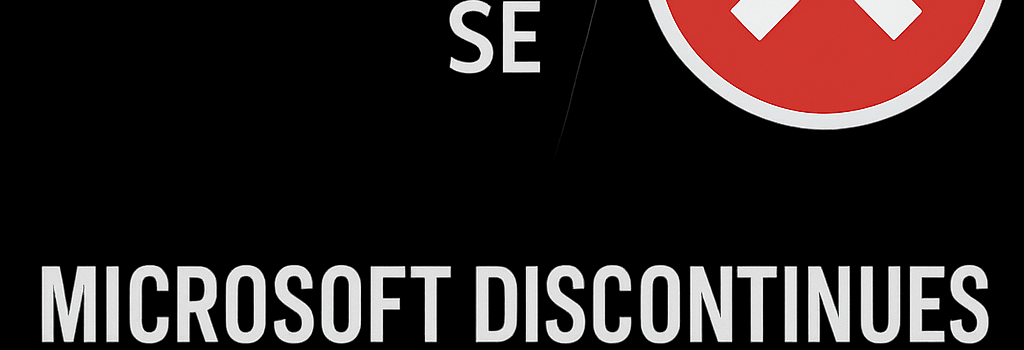Microsoft Discontinues Windows 11 SE: ChromeOS Rival Fails

Overview
In a quiet announcement buried in a Microsoft support document (first spotted by Dr. Windows), the company confirmed it will end all updates for Windows 11 SE in October 2026, coinciding with the retirement of Windows 11 24H2. Launched in 2021 as a purpose-built education OS to take on Google’s Chromebook dominance in classrooms, Windows 11 SE never made significant inroads and now joins a long list of underperforming projects aimed at low-cost laptop buyers.
1. Lifecycle of Microsoft’s ChromeOS Competitors
- Windows 8.1 with Bing (2014): Offered discounted licenses to OEMs in exchange for setting Bing as the default search engine.
- Windows 10 S (2017): Locked devices to Microsoft Store apps only; later evolved into “S Mode” in 2018 to allow easy, free switching.
- Windows 11 SE (2021): A standalone SKU, not just S Mode, pre-installed on select low-end education devices like Microsoft’s Surface Laptop SE.
Each iteration promised tighter security, lower costs, and simpler management, yet none reversed ChromeOS’s growing classroom market share, which reached 60% in U.S. K–12 districts by Q1 2025 (Gartner).
2. Technical Specifications & Feature Trade-Offs
Windows 11 SE was optimized for entry-level hardware:
- Processor: Intel Celeron N4020 / AMD A4-9120C
- Memory: 4 GB LPDDR4x RAM
- Storage: 64 GB eMMC or 128 GB SSD
- Display: 11.6″ HD (1366×768) IPS
To boost performance and reduce distractions, Microsoft removed:
- Built-in apps like Paint 3D, Xbox Game Bar, and certain background services.
- Support for sideloaded Win32 applications outside of core utilities.
- Live tile animations to conserve CPU/GPU cycles.
Administrators managed devices via Microsoft Intune for Education and enforced policies with Azure AD. Students’ documents synced automatically to OneDrive, ensuring continuity across devices.
3. Market Impact and Adoption Rates
Despite deep integration with Microsoft 365 and Windows Autopilot, Windows 11 SE struggled to match the sub-$200 price points of many Chromebooks, which often feature Chrome Enterprise upgrades at no extra cost. Key metrics:
- K–12 adoption: ~5% share of newly deployed Windows laptops in 2023 vs. 50% for Chromebooks (IDC).
- IT satisfaction: Administrators cited simplified updates but criticized limited offline functionality (TechValidate survey, 2024).
- Device returns: 3% higher RMA rate than comparable ChromeOS units, primarily due to OS restrictions causing user confusion.
4. Comparative Analysis: Windows 11 SE vs. ChromeOS
“ChromeOS remains the default for budget education devices due to its lower TCO and faster boot times,” says Angela Marcus, Senior Analyst at Forrester.
Benchmarks show ChromeOS boots in under 10 seconds on low-end hardware, while Windows 11 SE averages 18 seconds. Security patches on ChromeOS auto-apply on reboot; Windows SE relied on monthly cumulative updates via Windows Update for Business.
5. Future Directions: From SE to Cloud PCs
As Windows 11 SE sunsets, Microsoft is shifting focus to cloud-based offerings:
- Windows 365 Education: Virtual Cloud PCs preconfigured with education profiles, managed centrally in Azure.
- Azure Virtual Desktop: Scalable, multi-user Windows sessions accessible on any device, including Chromebooks.
- ChromeOS Flex: Microsoft surfaces testing support for running Edge and Defender on this adaptable OS.
6. Expert Opinions
Dr. Markus Heid, EdTech Consultant: “Windows 11 SE was technically sound but arrived late. With many districts entrenched in Google’s ecosystem, a pivot to cloud PC solutions makes strategic sense.”
Lisa Barnes, CIO of Cleveland Schools: “Our pilot SE program taught us the value of policy lockdowns but also highlighted user frustration when moving off-campus without reliable internet.”
7. Migration Strategies for Schools
- Upgrade devices to Windows 11 Pro in S Mode for continued app restrictions and policy enforcement.
- Adopt Windows 365 for Education to centralize software delivery and offload processing to Azure.
- Consider ChromeOS Flex on existing hardware to leverage lightweight management via Google Admin Console.
Microsoft recommends transitioning to a Windows 11 edition that aligns with your existing Intune and Azure AD setup to ensure uninterrupted security updates post-October 2026.